Everyone remembers the song of the tortoise Tortilla performed by Rina Zelena from the film "The Adventure of Buratino". It sounds to the accompaniment of a mandolin. And Marina Tsvetaeva also has a romantic mention in her poems:
“In a huge linden garden,
- Innocent and ancient -
I'm walking with a mandolin
In a very long outfit .. "
How to choose a mandolin? What instrument to give preference to if you are just starting to study or play music professionally.
Content
A bit of history
There is no reliable information about the time when the mandolin appeared. As noted by the famous German performer M. Wilden-Hüsgen "... it is only possible to roughly outline the line of development of the instrument ..."

At the end of the 18th century, you can hear the sound of a mandolin in Russia. Its ancestor is the mandola lute, which appeared in Italy seven centuries ago, which gradually appears in many countries, changing its name (mandola, mandora, pandurin) and characteristics.
Italian romance
The Vinacchia family from Naples, renowned musical masters, have designed an updated model with a curved top. The strings were replaced with metal ones and tuned in fifths, just like a violin. In those days in Naples, stornelli and rispetti - Tuscan songs accompanied by a mandolin became popular among local youths. Since 1835, in a small town near Naples, an annual competition of performers and composers of Neapolitan songs has been held. The performer of the famous "Santa Lucia" singer T. Cottrau took part in this event.

In 1772, Antonio Vinaccia made constructive changes that influenced the sound quality of the mandolin. This particular specimen is on display in the London Museum. Another copy of 1763 is now kept in the California Museum of Musical Instruments. Well, the "younger sister" of 1744 is kept at the Royal Conservatory in Brussels.
At the beginning of the 19th century, other, more modern musical trends began to supplant the mandolin, and it remained popular only in Italy. The manufacturing process almost disappears.
In 1835, Pasquale Vinacchia made fundamental changes to the design of the classic mandolin. This helps the musician to produce a richer, brighter melodious sound corresponding to the era of romanticism. The "golden age" for the mandolin begins in the second half of the 19th century.

During these years, the bourgeoisie is fond of playing the mandolin, among them the future queen of Italy Margarita of Savoy. P.Vinaccia made a personalized copy especially for her.
Mandolin is gradually gaining recognition not only in European countries, but also in America, Japan, Australia. Her melodic overflows are heard in musical styles: jazz, country, blues.
Russian page
In Russia, since the 1850s, the mandolin has been included in the repertoire of musical evenings of aristocratic houses. Societies of mandolinists were created in Moscow and St. Petersburg, and at the end of the 19th century music literature appeared, which could be used by anyone who wanted to learn how to play. In the 70s of the XIX century, the musician from Italy Ginislao Paris opened a circle of mandolinists and guitarists in St. Petersburg, which soon became the first Neapolitan orchestra. During the years of fascist Italy, the instrument becomes its symbol.
In Soviet times, the mandolin is gaining popularity again.In many films, the musical accompaniment includes the accompaniment of this instrument.

She was present in ensembles of the Union republics along with folk instruments.
Structure
Ancient mandolins have a curved almond shape, modern, as we call the "onion", appeared at the end of the 19th century. At the beginning of the 20th century, mandolin became so popular that not only individual masters and manufactories of Naples, but also other countries of the world: Germany, France, USA, etc., began to produce it.
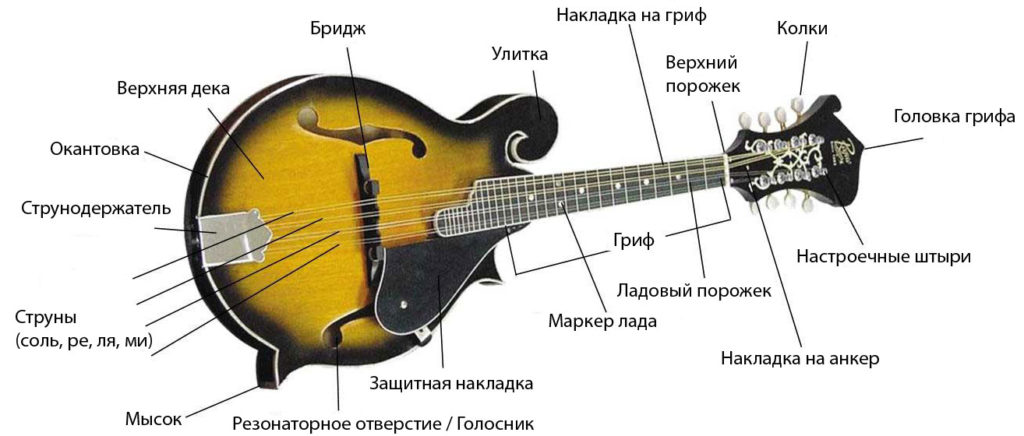
The stage of creating a tool is complex, requiring painstaking work from the master.
- The first and most important is the manufacture of the bottom or body of the instrument, which plays the role of a resonator. It consists of several riveting segments made of maple, walnut or cypress wood. The wooden planks are soaked and the softened ones are shaped with the help of a hot iron. Then, the master grinds and finalizes the tool with a chisel and hammer.
- The soundboard is made from ebony using the same technique as the guitar. A stand for strings is installed on it without fixing to the body.
- The short neck is made of mahogany, cedar, larch or walnut wood. It is divided by metal saddles into frets, of which there can be from 11 to 24. A tuning mechanism is located at the end of the neck to tension the strings.
- The body is coated with a special varnish with nitrocellulose and is additionally decorated with, for example, inlay. The length of the instrument body is 33 cm, and the total is 60 cm.
Sound is produced using a pick-pick made of tortoiseshell or synthetic material.
Production
A pioneering wave in the design of the mandolin at the turn of the 17th and 19th centuries was introduced by American craftsmen, who patented the aluminum model. The most successful can be considered Orville Gibson, who for a long time studied the possibility of introducing the constructive capabilities of the violin into the structure of the mandolin. Musical instruments of the Gibson firm are still popular among performers.

The Kalache family played a huge role in the preservation and development of musical traditions in Italy. Maria organized a school for mandolinists in Naples, her brother Giuseppe was engaged in the manufacture of mandolins and violins for export, after his death, brother Raffaele continued the family business. Currently, the Kalache factory is considered the leading manufacturer of plucked string. In the catalog, the models "Classico A" and the more modern "Annamaria" are considered the best.
Italian models
In Ferrara, Gabriele Pandini's factory produces several types of mandolins.
Today in many countries you can find tools from the G. Puglisi factory - Reale and Figli. The Reale family from Sicily has been producing them since the 20s of the XIX century since the beginning of the construction of the factory for the production of violins and cellos. The largest plucked string production was founded in 1880 by Giuseppe Reale. The famous name appeared only at the beginning of the 20th century.
The factory's craftsmen were also engaged in the manufacture of strings and bows. In 1943, the factory was destroyed as a result of air raids, and unique tools were sent to the USA, Canada and Australia. In 1875, Julius Zimmerman founded his own company, which, after 7 years, became the main supplier to Russia, headquartered in Leipzig.
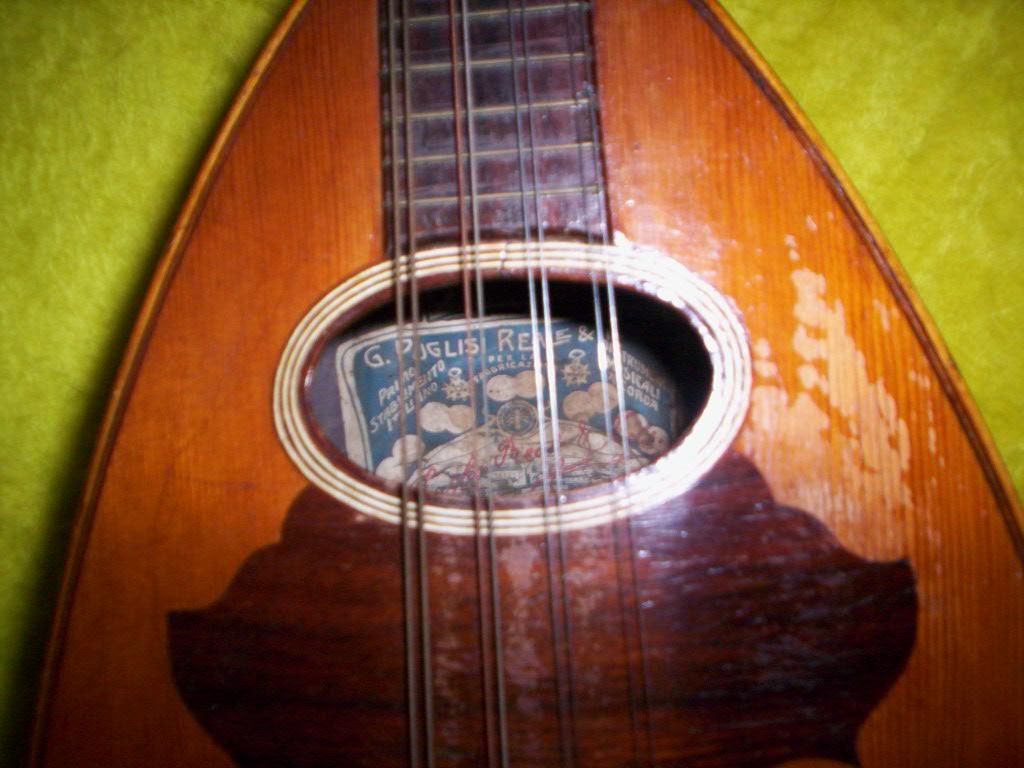
Mandolins of the Land of the Soviets
In 1882-1885. branches were opened in Moscow, in 1897 - in London. In the pre-war period in Leningrad, the country's largest company for the manufacture of folk instruments, created on the basis of the Shruder piano factory, operated. In 1922 she received the name of Lunacharsky. Plucked plucked instruments were also produced here for widespread use; there was even a separate workshop at the factory - a mandolin workshop. In 1934, 135 domestic-made machine tools made in Voronezh were in operation. About 390 thousand copies were produced per year.
Since the middle of the last century, the products of the factory have won prizes at international exhibitions more than once. In the early 90s, the enterprise was privatized into JSC "Arfa". It existed until 2005, all equipment and premises were sold.The ancient dynasty of the Neapolitan craftsmen Vinaccia consisted of 9 people. Nowadays, their famous mandolins are in museums in different countries: England, USA, Belgium, Spain.
Varieties of Mandolin
Different models differ in body shape, number of strings and range, this determines many types of instrument. There are two forms: pear-shaped (Neapolitan) and flat Portuguese, in which, instead of a voice hole, there are two resonator f-holes on the lower soundboard, like a violin.
Existing types:
- Neapolitan - classic with 4 double strings;
- Milan with 5 strings;
- Sicilian is a Central European variant used when playing Mexican music;
- Mandola is the ancestor of the mandolin;
- Octave;
- Mandolin-luta - an improved model of the master and composer Raffaele Kalache at the beginning of the last century;
- Mando bass - double bass served as the basis;
- The Portuguese version has flat top and bottom decks. She is popular in the USA and Latin America;
- The electromandoline appeared in the 30s of the last century in the United States. It is also made of wood and has a magnetic pickup. Strings can be double or single;
- Irish bouzouki - this ancestor has Greek roots, double strings (4 pieces).
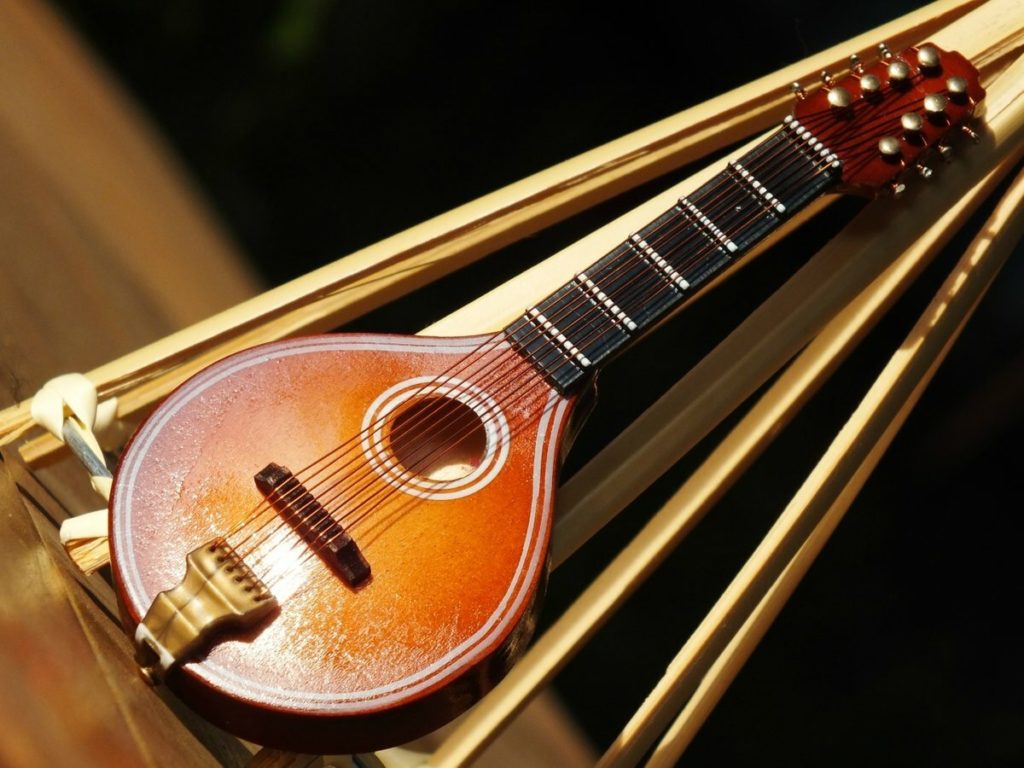
The teardrop-shaped Neapolitan mandolins have a softer yet stronger sound than the Portuguese version.
Execution
Despite its ancient origin, the ancestor of the lute is not forgotten in our time. Its sound can be heard in a classical work, as well as in modern trends of musical styles: country, folk, blues, jazz, in Celtic music. Many famous composers wrote their concerts for mandolin, among them: Vivaldi, Pergolesi, Pasielo, Kauffmann, Lecce, Verdi, Mozart used the instrument in opera performances.
The guitarist of the group "Aria" plays the mandolin, her accompaniment is heard in the ballad "Paradise Lost" and other compositions. Foreign rock bands also use the instrument at concerts, for example the German metal band In Extremo.
Among the worthy companies engaged in the manufacture of mandolins, experts distinguish the following: The Loar, Eastman and Kentucky. The tools of these manufacturers are quite expensive, it is recommended to order them from abroad.
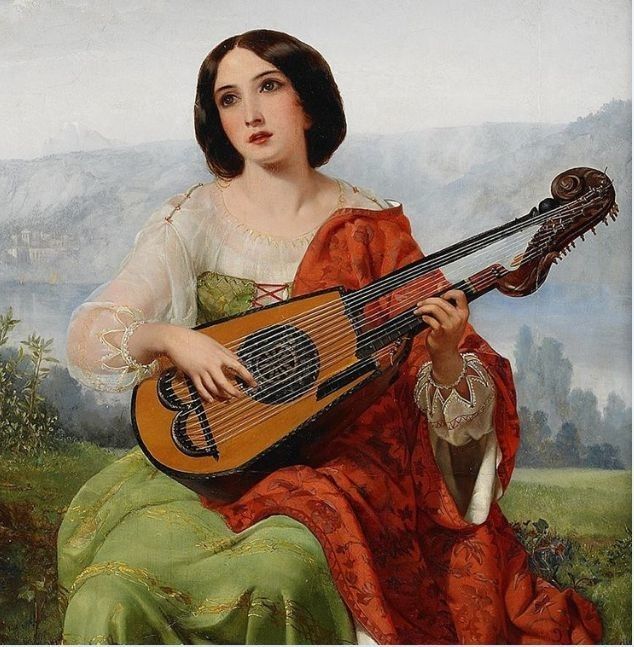
For beginners, the Czech-made Strunal mandolin, formerly known as Cremona, is recommended. Many teachers recommend that their students start learning on the onion - the Neapolitan version of the small musical instrument factory named after A. Lunacharsky in Leningrad.
There are two main areas:
Academic tradition
STRUNAL (CREMONA) 597I
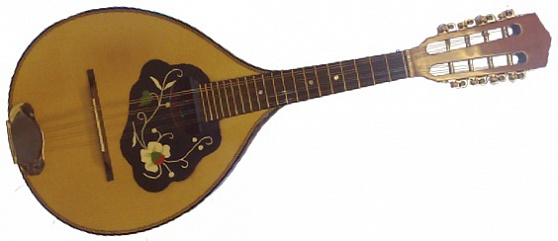
Portuguese model from a Czech manufacturer, can be used to learn how to play an instrument. The top is made of spruce wood for a brighter sound. The back and sides look interesting - the stained maple planks are fanned out. Experts recommend replacing the strings immediately, as their quality leaves much to be desired. Price: from 9000 rubles.
Advantages:
- Bright sound
- Price.
Disadvantages:
- Tight pegs;
- Strings.
CARAYA MA-002-BS
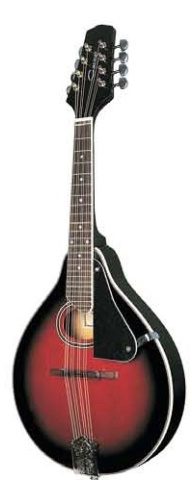
Not a bad student tool. The eight-stringed mandolin is made of American linden and rosewood. Sanders color, round resonator hole. The cabinet is not made from a solid piece of wood, which affects the sound.
Price: from 5000 rubles.
Advantages:
- Good value for money;
- Suitable for a beginner.
Disadvantages:
- Minor manufacturing flaws.
Country
Kentucky KM-150
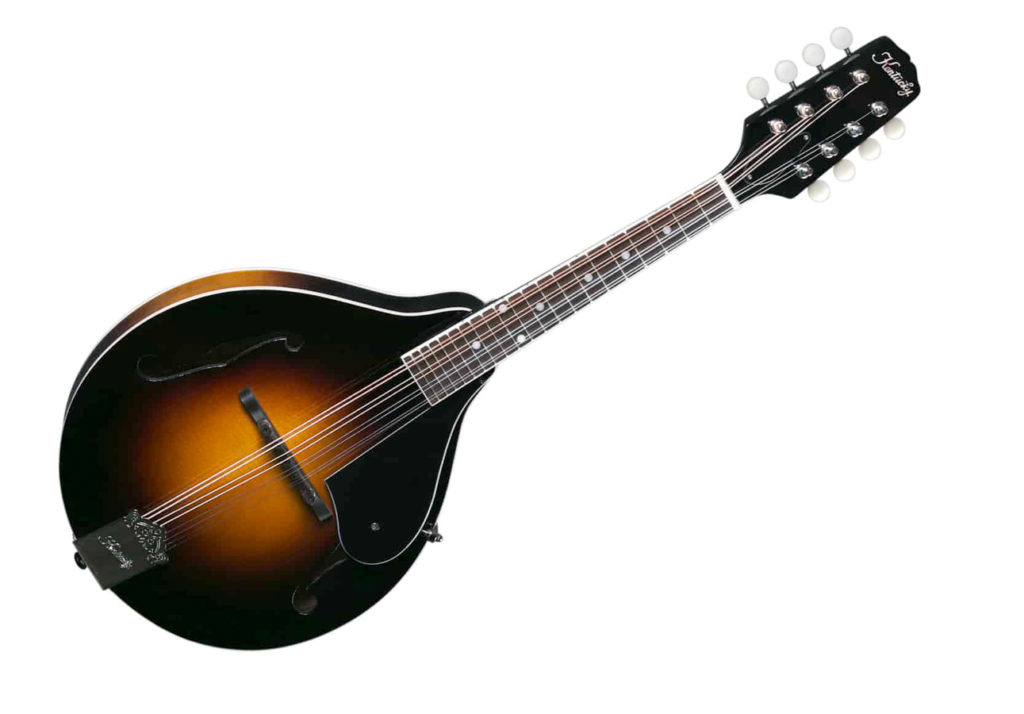
A-style drop-shaped. For the best timbre and volume, the top is hollowed out from a solid piece of resonant spruce, while the back and sides are made of maple. The neck has a comfortable shape, which determines the ease of playing the instrument. The body protector is made of black plastic and features an inlaid mother-of-pearl logo on the headstock. The mandolin has 21 frets, 12 on the fretboard. The nut is made of bone, the lower one is made of rosewood.
Brand country: USA.
Cost: from 28,000 rubles.
Advantages:
- High sound quality;
- Reliable manufacturer.
Disadvantages:
- Not.
Experts recommend buying abroad. The Chinese version loses in sound quality.
Ibanez M510E-BS

The tool is manufactured by a well-known Japanese brand. The mandolin has a teardrop shape. The top is made of spruce, while the sides and back are made of mahogany. The instrument is equipped with a magnetic pickup and a tone control for better sound reproduction, 20 frets.
Price: from 15,000 rubles.
Advantages:
- Excellent sound quality;
- Price.
Disadvantages:
- Not found.
Eastman MD 315

Bluegrass F-Style, eight-string. Spruce wood was used, the back and sides are of maple. The cover is ebony.
Cost - from 65,000 rubles.
Advantages:
- Suitable for any musical style.
- Price.
Disadvantages:
- Not found.
Stagg M30
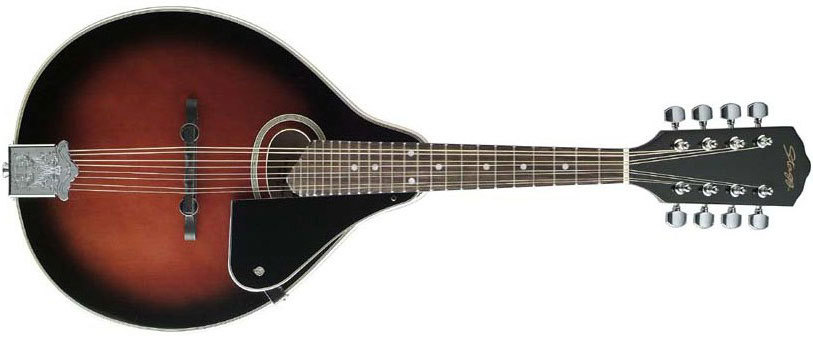
Bluegrass is a Belgian firm belonging to the EMD brand. High-quality varieties of spruce and linden are used in the production. Handwork is partly used. The fingerboard is made of rosewood.
Price - from 10,000 rubles.
Advantages:
- Price;
- Reliable brand.
Disadvantages:
- Not.
Mandolin is a cheerful musical instrument that has recently become popular not only among amateurs, but also professionals.












